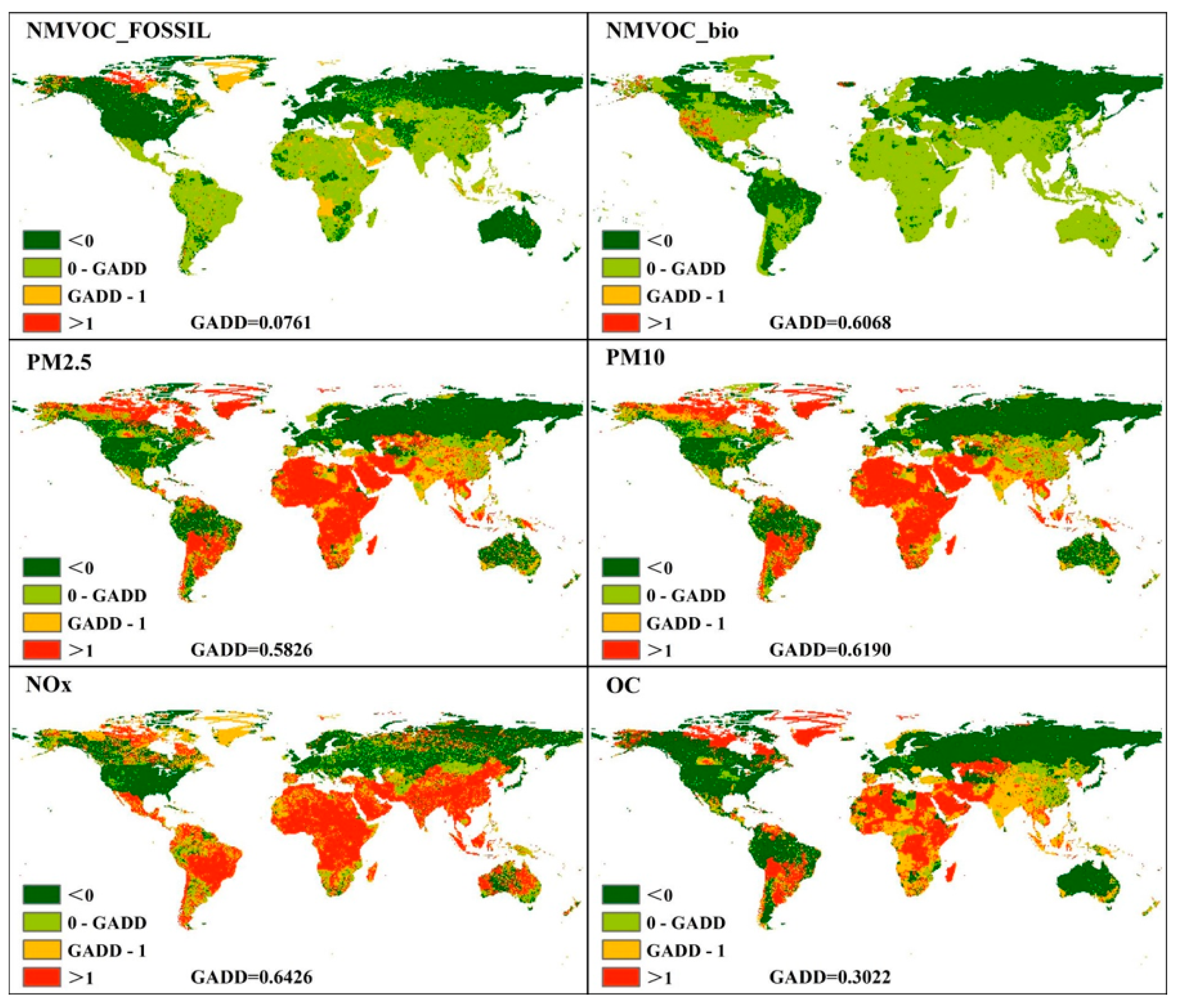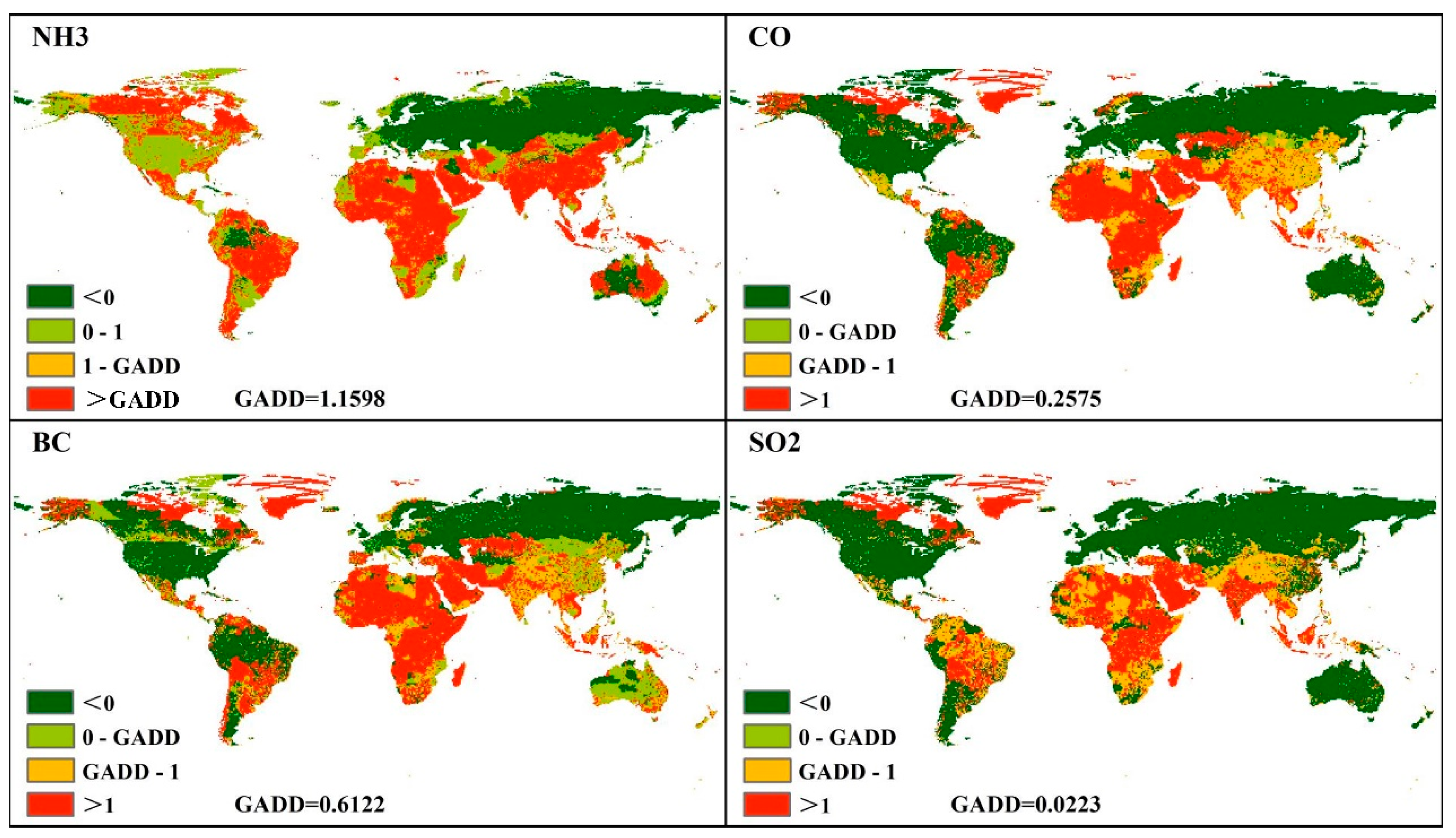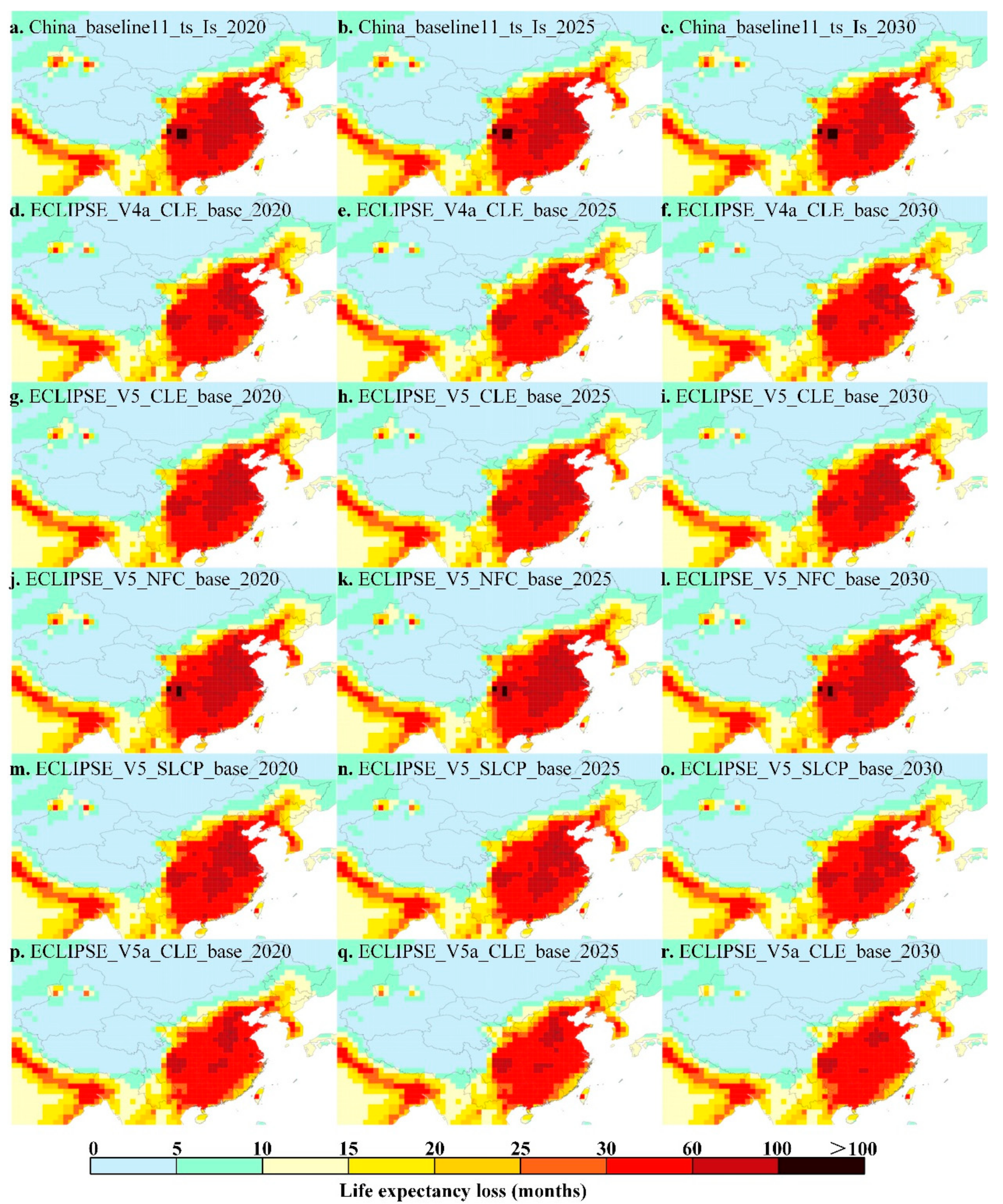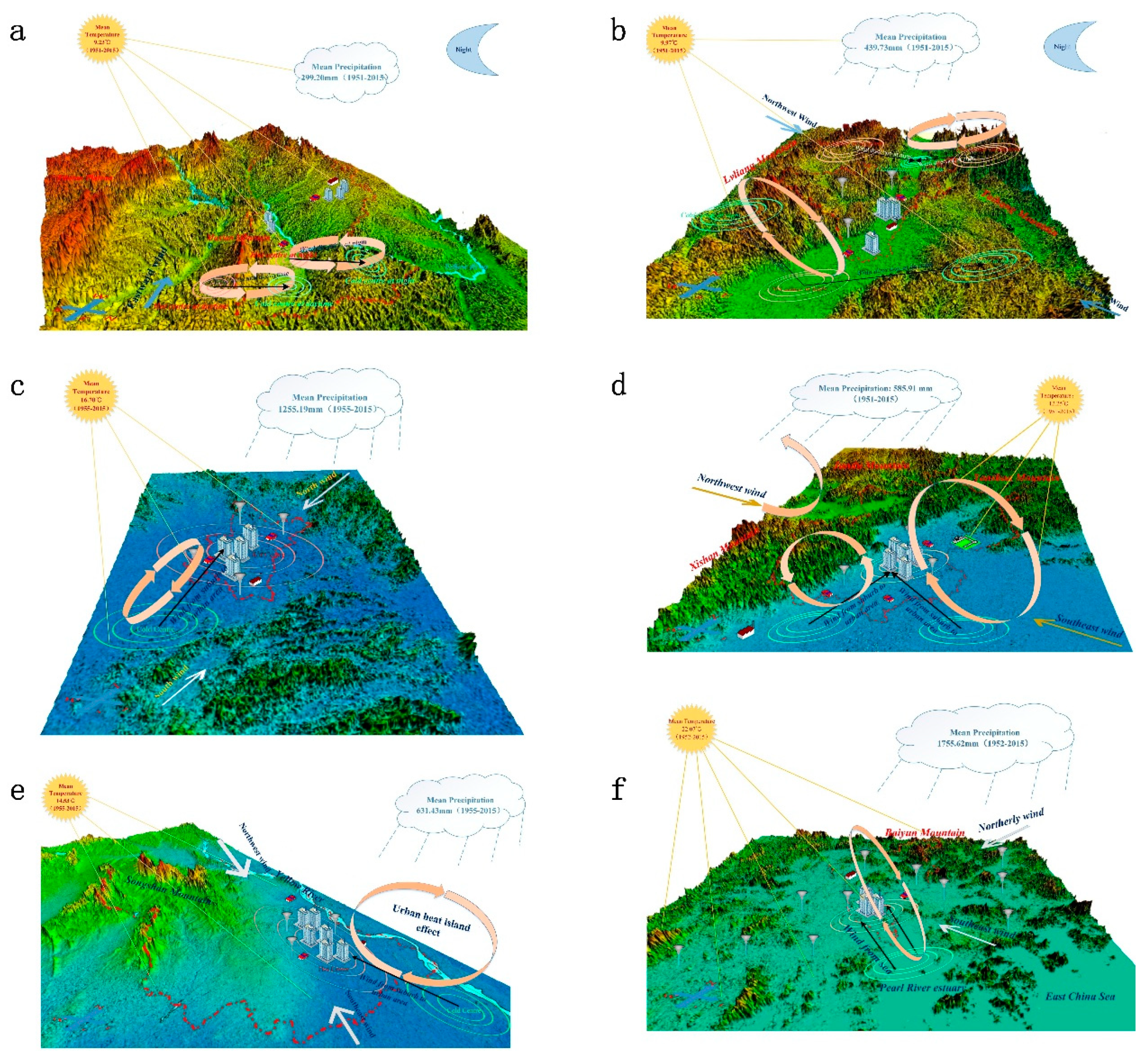Response of Global Air Pollutant Emissions to Climate Change and Its Potential Effects on Human Life Expectancy Loss
Abstract
1. Introduction
2. Materials and Methods
2.1. Data
2.2. The GAINS Model
2.3. Spatial Correlation Analysis Method
2.4. Terrain Relief Model
2.5. Redundancy Analysis Model
2.6. Spatial Dynamic Model
3. Results
3.1. Dynamic Change of Global Air Pollutant Emissions
3.2. Spatial Correlation between Air Pollutant and Natural Conditions
3.3. Response of Air Pollutant Emissions to Climate Change
3.4. Potential Effects of Air Pollutant Emissions Because of Climate Change on Human Health
4. Discussion
4.1. Mechanism of Air Pollutant Diffusion
5. Conclusions
Supplementary Materials
Author Contributions
Funding
Conflicts of Interest
References
- Rao, S.; Pachauri, S.; Dentener, F.; Kinney, P.; Klimont, Z.; Riahi, K.; Schoepp, W. Better air for better health: Forging synergies in policies for energy access, climate change and air pollution. Glob. Environ. Chang. 2013, 23, 1122–1130. [Google Scholar] [CrossRef]
- Weaver, C.P.; Liang, X.Z.; Zhu, J.; Adams, P.J.; Amar, P.; Avise, J.; Caughey, M.; Chen, J.; Cohen, R.C.; Cooter, E.; et al. A preliminary synthesis of modeled climate change impacts on US regional ozone concentrations. Bull. Am. Meteorol. Soc. 2009, 90, 1843–1863. [Google Scholar] [CrossRef]
- Pope, C.A., III; Burnett, R.T.; Thun, M.J.; Calle, E.E.; Krewski, D.; Ito, K.; Thurston, G.D. Lung cancer, cardiopulmonary mortality, and long-term exposure to fine particulate air pollution. JAMA 2002, 287, 1132–1141. [Google Scholar] [CrossRef] [PubMed]
- West, J.J.; Smith, S.J.; Silva, R.A.; Naik, V.; Zhang, Y.; Adelman, Z. Co-benefits of global greenhouse gas mitigation for future air quality and human health. Nat. Clim. Chang. 2013, 3, 885–889. [Google Scholar] [CrossRef] [PubMed]
- Lelieveld, J.; Evans, J.S.; Fnais, M.; Giannadaki, D.; Pozzer, A. The contribution of outdoor air pollution sources to premature mortality on a global scale. Nature 2015, 525, 367. [Google Scholar] [CrossRef] [PubMed]
- Yang, L.E.; Hoffmann, P.; Scheffran, J. Health impacts of smog pollution: The human dimensions of exposure. Lancet Planet. Health 2017, 1, e132–e133. [Google Scholar] [CrossRef]
- Yang, L.; Hoffmann, P.; Scheffran, J.; Rühe, S.; Fischereit, J.; Gasser, I. An Agent-Based Modeling Framework for Simulating Human Exposure to Environmental Stresses in Urban Areas. Urban Sci. 2018, 2, 36. [Google Scholar] [CrossRef]
- Nakicenovic, N.; Alcamo, J.; Davis, G.; Vries, B.D.; Fenhann, J.; Gaffin, S.; Gregory, K.; Grubler, A.; Jung, T.Y.; Kram, T.; et al. Emissions Scenarios. A Special Report of IPCC Working Group III; Intergovernmental Panel on Climate Change: Cambridge, UK, 2000. [Google Scholar]
- Sanderson, M.G.; Jones, C.D.; Collins, W.J.; Johnson, C.E.; Derwent, R.G. Effect of climate change on isoprene emissions and surface ozone levels. Geophys. Res. Lett. 2003, 30, 1936. [Google Scholar] [CrossRef]
- Naik, V.; Delire, C.; Wuebbles, D.J. Sensitivity of global biogenic isoprenoid emissions to climate variability and atmospheric CO2. J. Geophys. Res. 2004, 109, D06301. [Google Scholar] [CrossRef]
- Lathiere, J.; Hauglustaine, D.A.; De Noblet-Ducoudre, N.; Krinner, G.; Folberth, G.A. Past and future changes in biogenic volatile organic compound emissions simulated with a global dynamic vegetation model. Geophys. Res. Lett. 2005, 32, L20818. [Google Scholar] [CrossRef]
- Arneth, A.; Niinemets, U.; Pressley, S.; Back, J.; Hari, P.; Karl, T.; Noe, S.; Prentice, I.C.; Serca, D.; Hickler, T.; et al. Process-based estimates of terrestrial ecosystem isoprene emissions: Incorporating the effects of a direct CO2−isoprene interaction. Atmos. Chem. Phys. 2007, 7, 31–53. [Google Scholar] [CrossRef]
- Spracklen, D.V.; Mickley, L.J.; Logan, J.A.; Hudman, R.C.; Yevich, R.; Flannigan, M.D.; Westerling, A.L. Impacts of climate change from 2000 to 2050 on wildfire activity and carbonaceous aerosol concentrations in the western United States. J. Geophys. Res. Atmos. 2009, 114, D20301. [Google Scholar] [CrossRef]
- Guenther, A.B.; Jiang, X.; Heald, C.L.; Sakulyanontvittaya, T.; Duhl, T.; Emmons, L.K.; Wang, X. The Model of Emissions of Gases and Aerosols from Nature version 2.1 (MEGAN2.1): An extended and updated framework for modeling biogenic emissions. Geosci. Model Dev. 2012, 5, 1471–1492. [Google Scholar] [CrossRef]
- Slezakova, K.; Morais, S.; do Carmo Pereira, M. Forest fires in Northern region of Portugal: Impact on PM levels. Atmos. Res. 2013, 127, 148–153. [Google Scholar] [CrossRef]
- Wang, Y.; Shen, L.; Wu, S.; Mickley, L.; He, J.; Hao, J. Sensitivity of surface ozone over China to 2000−2050 global changes of climate and emissions. Atmos. Environ. 2013, 75, 374–382. [Google Scholar] [CrossRef]
- Fiore, A.M.; Naik, V.; Leibensperger, E.M. Air Quality and Climate Connections. J. Air Waste Manag. Assoc. 2015, 65, 645–685. [Google Scholar] [CrossRef] [PubMed]
- Von Schneidemesser, E.; Monks, P.S.; Allan, J.D.; Bruhwiler, L.; Forster, P.; Lauer, D.F.A.; Morgan, W.T.; Paasonen, P.; Righi, M.; Sindelarova, K.; et al. Chemistry and the linkages between air quality and climate change. Chem. Rev. 2015, 115, 3856–3897. [Google Scholar] [CrossRef]
- Silva, R.A.; West, J.J.; Lamarque, J.-F.; Shindell, D.T.; Collins, W.J.; Faluvegi, G.; Folberth, G.A.; Horowitz, L.W.; Nagashima, T.; Naik, V.; et al. Future global mortality from changes in air pollution attributable to climate change. Nat. Clim. Chang. 2017, 7, 647–651. [Google Scholar] [CrossRef]
- Jacob, D.J.; Winner, D.A. Effect of climate change on air quality. Atmos. Environ. 2009, 43, 51–63. [Google Scholar] [CrossRef]
- Dawson, J. Atmospheric science: Quiet weather, polluted air. Nat. Clim. Chang. 2014, 4, 664–665. [Google Scholar] [CrossRef]
- Cai, W.; Li, K.; Liao, H.; Wang, H.; Wu, L. Weather conditions conducive to Beijing severe haze more frequent under climate change. Nat. Clim. Chang. 2017, 7, 257–262. [Google Scholar] [CrossRef]
- Wu, P.; Ding, Y.; Liu, Y. Atmospheric circulation and dynamic mechanism for persistent haze events in the Beijing–Tianjin–Hebei region. Adv. Atmos. Sci. 2017, 34, 429–440. [Google Scholar] [CrossRef]
- Liu, J.; Cui, S. Meteorological influences on seasonal variation of fine particulate matter in cities over southern Ontario, Canada. Adv. Meteorol. 2014, 2014, 169476. [Google Scholar] [CrossRef]
- Ramsey, N.R.; Klein, P.M.; Moore, B., III. The impact of meteorological parameters on urban air quality. Atmos. Environ. 2014, 86, 58–67. [Google Scholar] [CrossRef]
- Russo, A.; Trigo, R.M.; Martins, H.; Mendes, M.T. NO2, PM10 and O3 urban concentrations and its association with circulation weather types in Portugal. Atmos. Environ. 2014, 89, 768–785. [Google Scholar] [CrossRef]
- Tai, A.P.; Mickley, L.J.; Jacob, D.J.; Leibensperger, E.M.; Zhang, L.; Fisher, J.A.; Pye, H.O.T. Meteorological modes of variability for fine particulate matter (PM2.5) air quality in the United States: Implications for PM2.5 sensitivity to climate change. Atmos. Chem. Phys. 2012, 12, 3131–3145. [Google Scholar] [CrossRef]
- Pearce, J.L.; Beringer, J.; Nicholls, N.; Hyndman, R.J.; Tapper, N.J. Quantifying the influence of local meteorology on air quality using generalized additive models. Atmos. Environ. 2011, 45, 1328–1336. [Google Scholar] [CrossRef]
- Dayan, U.; Levy, I. Relationship between synoptic-scale atmospheric circulation and ozone concentrations over Israel. J. Geophys. Res. Atmos. 2002, 107, 4813. [Google Scholar] [CrossRef]
- Zhang, H.; Wang, Y.; Park, T.W.; Deng, Y. Quantifying the relationship between extreme air pollution events and extreme weather events. Atmos. Res. 2017, 188, 64–79. [Google Scholar] [CrossRef]
- Wang, Y.; Qi, Y.; Hu, J.; Zhang, H. Spatial and temporal variations of six criteria air pollutants in 31 provincial capital cities in china during 2013–2014. Environ. Int. 2014, 73, 413–422. [Google Scholar] [CrossRef]
- Hoag, H. Air quality to suffer with global warming. Study suggests effects of climate change will slow air circulation around the world. Nature. News, 22 June 2014. [Google Scholar]
- Flocas, H.; Kelessis, A.; Helmis, C.; Petrakakis, M.; Zoumakis, M.; Pappas, K. Synoptic and local scale atmospheric circulation associated with air pollution episodes in an urban Mediterranean area. Theor. Appl. Climatol. 2009, 95, 265–277. [Google Scholar] [CrossRef]
- Taylor, K.E.; Stouffer, R.J.; Meehl, G.A. An overview of CMIP5 and the experiment design. Bull. Am. Meteorol. Soc. 2012, 93, 485–498. [Google Scholar] [CrossRef]
- Shindell, D.; Kuylenstierna, J.C.I.; Vignati, E.; van Dingenen, R.; Amann, M.; Klimont, Z.; Anenberg, S.C.; Muller, N.; Janssens-Maenhout, G.; Raes, F.; et al. Simultaneously Mitigating Near-Term Climate Change and Improving Human Health and Food Security. Science 2012, 335, 183–189. [Google Scholar] [CrossRef]
- Liu, F.; Klimont, Z.; Zhang, Q.; Cofala, J.; Zhao, L.; Huo, H.; Nguyen, B.; Schöpp, W.; Sander, R.; Zheng, B.; et al. Integrating mitigation of air pollutants and greenhouse gases in Chinese cities: Development of GAINS-City model for Beijing. J. Clean. Prod. 2013, 58, 25–33. [Google Scholar] [CrossRef]
- Klimont, Z.; Kupiainen, K.; Heyes, C.; Purohit, P.; Cofala, J.; Rafaj, P.; Borken-Kleefeld, J.; Schöpp, W. Global anthropogenic emissions of particulate matter including black carbon. Atmos. Chem. Phys. 2017, 17, 8681–8723. [Google Scholar] [CrossRef]
- Duncanson, L.I.; Niemann, K.O.; Wulder, M.A. Estimating forest canopy height and terrain relief from GLAS waveform metrics. Remote Sens. Environ. 2010, 114, 138–154. [Google Scholar] [CrossRef]
- Feng, Z.; Tang, Y.; Yang, Y.; Zhang, D. Relief degree of land surface and its influence on population distribution in China. J. Geogr. Sci. 2008, 18, 237–246. [Google Scholar] [CrossRef]
- Ter Braak, C.J.; Smilauer, P. CANOCO Reference Manual and CanoDraw for Windows User’s Guide: Software for Canonical Community Ordination (Version 4.5); Microcomputer Power: New York, NY, USA, 2002; p. 500. [Google Scholar]
- Liu, J.; Zhang, Z.; Xu, X.; Kuang, W.; Zhou, W.; Zhang, S.; Li, R.; Yan, C.; Yu, D.; Wu, S.; et al. Spatial patterns and driving forces of land use change in china during the early 21st century. J. Geogr. Sci. 2010, 20, 483–494. [Google Scholar] [CrossRef]
- Wang, Z.-R.; Zhou, B.; Wang, S.S.; Yang, S.N. Observation on the spatial distribution of air pollutants by active multi-axis differential optical absorption spectroscopy. Acta Phys. Sin. 2011, 6, 60. [Google Scholar]
- Pfeiffer, H.; Baumbach, G.; Sarachaga-Ruiz, L.; Kleanthous, S.; Poulida, O.; Beyaz, E. Neural modelling of the spatial distribution of air pollutants. Atmos. Environ. 2009, 43, 3289–3297. [Google Scholar] [CrossRef]
- Chen, H.; Huang, Y.; Shen, H.; Chen, Y.; Ru, M.; Chen, Y.; Lin, N.; Su, S.; Zhuo, S.; Zhong, Q.; et al. Modeling temporal variations in global residential energy consumption and pollutant emissions. Appl. Energy 2016, 184, 820–829. [Google Scholar] [CrossRef]
- Yuan, X.; Mu, R.; Zuo, J.; Wang, Q. Economic development, energy consumption, and air pollution: A critical assessment in China. Hum. Ecol. Risk Assess. Int. J. 2015, 21, 781–798. [Google Scholar] [CrossRef]
- Doman, G. A Long-Run Relationship Investigation of Energy Consumption and Air Pollution in Togo. Int. J. Eng. Sci. Res. Technol. 2014, 6, 732–739. [Google Scholar]
- Krzyzanowski, J.; Manninen, S. Air pollution at the local, regional, and global scale: A summary of the 2014 air pollution workshop in Guadalajara, Mexico. EM Mag. 2014, 2014, 32–35. [Google Scholar]
- Lanorte, A.; Aromando, A.; Desantis, F.; Lasaponara, R. Space Monitoring of air pollution using satellite time series: From a global view down to local scale. In Proceedings of the EGU General Assembly Conference Abstracts, Vienna, Austria, 7–12 April 2013; Volume 15, p. 13624. [Google Scholar]
- Mensink, C.; De Ridder, K.; Deutsch, F.; Lefebre, F.; Van de Vel, K. Examples of scale interactions in local, urban, and regional air quality modelling. Atmos. Res. 2008, 89, 351–357. [Google Scholar] [CrossRef]
- Chen, Z.; Wang, J.N.; Ma, G.X.; Zhang, Y.S. China tackles the health effects of air pollution. Lancet 2013, 382, 1959–1960. [Google Scholar] [CrossRef]
- Hou, Q.; An, X.; Wang, Y.; Tao, Y.; Sun, Z. An assessment of China’s PM10−related health economic losses in 2009. Sci. Total Environ. 2012, 435–436, 61–65. [Google Scholar] [CrossRef]
- Smith, K.R. National burden of disease in India from indoor air pollution. Proc. Natl. Acad. Sci. USA 2000, 97, 13286. [Google Scholar] [CrossRef]
- Matus, K.; Nam, K.M.; Selin, N.E.; Lamsal, L.N.; Reilly, J.M.; Paltsev, S. Health damages from air pollution in china. Glob. Environ. Chang. 2012, 22, 55–66. [Google Scholar] [CrossRef]
- Gong, P.; Liang, S.; Carlton, E.J.; Jiang, Q.; Wu, J.; Wang, L.; Remais, J.V. Urbanization and health in China. Lancet 2012, 379, 843–852. [Google Scholar] [CrossRef]
- Chen, K.; Zhou, L.; Chen, X.; Ma, Z.; Liu, Y.; Huang, L.; Bi, J.; Kinney, P.L. Urbanization level and vulnerability to heat-related mortality in Jiangsu province, china. Environ. Health Perspect. 2016, 124, 1863–1869. [Google Scholar] [CrossRef]
- Clark, R.D.; Philbrick, C.R.; Ryan, W.F.; Doddridge, B.G.; Stehr, J.W. The effects of local and regional scale circulations on air pollutants during NARSTO-NEOPS 1999–2001. In Proceedings of the Fourth Conference on Atmospheric Chemistry: Urban, Regional, and Global-Scale Impacts of Air Pollutants, Orlando, FL, USA, 13–17 January 2002; pp. 125–132. [Google Scholar]
- Jeong, J.H.; Song, S.K.; Lee, H.W.; Kim, Y.K. Effects of high-resolution land cover and topography on local circulations in two different coastal regions of Korea: A numerical modeling study. Meteorol. Atmos. Phys. 2012, 118, 1–20. [Google Scholar] [CrossRef]
- Choi, H.; Zhang, Y.H.; Takahashi, S. Recycling of suspended particulates by the interaction of sea-land breeze circulation and complex coastal terrain. Meteorol. Atmos. Phys. 2004, 87, 109–120. [Google Scholar] [CrossRef]
- Zhao, M.; Pitman, A.J.; Chase, T. The impact of land cover change on the atmospheric circulation. Clim. Dyn. 2001, 17, 467–477. [Google Scholar] [CrossRef]
- Liu, L.; Talbot, R.; Lan, X. Influence of Climate Change and Meteorological Factors on Houston’s Air Pollution: Ozone a Case Study. Atmosphere 2015, 6, 623–640. [Google Scholar] [CrossRef]
- Li, L.; Qian, J.; Ou, C.Q.; Zhou, Y.X.; Guo, C.; Guo, Y. Spatial and temporal analysis of Air Pollution Index and its timescale-dependent relationship with meteorological factors in Guangzhou, China, 2001–2011. Environ. Pollut. 2014, 190, 75–81. [Google Scholar] [CrossRef]
- Ilten, N.; Selici, A.T. Investigating the impacts of some meteorological parameters on air pollution in Balikesir, Turkey. Environ. Monit. Assess. 2008, 140, 267–277. [Google Scholar] [CrossRef]
- Lesniok, M.R.; Caputa, Z.C. The role of atmospheric circulation in air pollution distribution in Katowice Region (Southern Poland). Int. J. Environ. Waste Manag. 2009, 4, 62–74. [Google Scholar] [CrossRef]






| Version | Release Date | Period Covered | Scenarios |
|---|---|---|---|
| V3 | November 2013 | 2005, 2008, 2009, 2010 | No future scenarios were developed |
| V4a | January 2014 | 2005, 2010, 2030, 2050 | Reference (assuming current legislation for air pollution—CLE). Maximum technically feasible reductions (MTFR) |
| V5 | April 2014 | 1990–2030, 2040, 2050 | Reference (assuming current legislation for air pollution—CLE), No further control (NFC). Short lived climate pollutants mitigation (SLCP) |
| V5a | July 2015 | 1990–2030, 2040, 2050 | Reference (assuming current legislation for air pollution—CLE), Short lived climate pollutants mitigation (SLCP), Maximum technically feasible reductions (MTFR), Climate scenario (2 degrees, CLE) |
| V6 | Forthcoming |
| Indicators | 1 | 2 | 3 | 4 | 5 | 6 | 7 | 8 | 9 | 10 | 11 | 12 | 13 | 14 | 15 | 16 |
|---|---|---|---|---|---|---|---|---|---|---|---|---|---|---|---|---|
| 1 | 1 | −0.0195 | −0.0584 | 0.0447 | −0.0278 | −0.0313 | −0.0883 | −0.0078 | −0.0319 | −0.1437 | −0.0605 | −0.2086 | −0.0118 | 0.0109 | −0.3251 | −0.3376 |
| 2 | −0.0195 | 1 | 0.4687 | −0.1938 | 0.0998 | 0.0428 | −0.0320 | −0.0016 | −0.0083 | −0.0421 | −0.0221 | −0.0704 | −0.0080 | 0.0000 | −0.1159 | −0.1207 |
| 3 | −0.0584 | 0.4687 | 1 | −0.1338 | 0.2099 | −0.0200 | −0.1081 | −0.0100 | −0.0425 | −0.1718 | −0.0747 | −0.2615 | −0.0143 | −0.0009 | −0.4029 | −0.4171 |
| 4 | 0.0447 | −0.1938 | −0.1338 | 1 | −0.0125 | −0.0174 | 0.0825 | 0.0086 | 0.0336 | 0.1291 | 0.0563 | 0.1988 | 0.0118 | 0.0011 | 0.3021 | 0.3137 |
| 5 | −0.0278 | 0.0998 | 0.2099 | −0.0125 | 1 | 0.0084 | −0.0514 | −0.0041 | −0.0062 | −0.0841 | −0.0354 | −0.1297 | −0.0069 | −0.0007 | −0.1975 | −0.1982 |
| 6 | −0.0313 | 0.0428 | −0.0200 | −0.0174 | 0.0084 | 1 | −0.0930 | −0.0097 | −0.0367 | −0.1628 | −0.0616 | −0.2260 | −0.0108 | −0.0005 | −0.3619 | −0.3745 |
| 7 | −0.0883 | −0.0320 | −0.1081 | 0.0825 | −0.0514 | −0.0930 | 1 | −0.0093 | 0.1284 | −0.1220 | 0.9896 | −0.3000 | −0.0155 | −0.0003 | −0.4354 | −0.4646 |
| 8 | −0.0078 | −0.0016 | −0.0100 | 0.0086 | −0.0041 | −0.0097 | −0.0093 | 1 | 0.0343 | −0.0219 | −0.0029 | −0.0307 | −0.0016 | 0.0000 | −0.0485 | −0.0500 |
| 9 | −0.0319 | −0.0083 | −0.0425 | 0.0336 | −0.0062 | −0.0367 | 0.1284 | 0.0343 | 1 | −0.0860 | 0.1486 | −0.1145 | −0.0062 | −0.0001 | −0.1942 | −0.2007 |
| 10 | −0.1437 | −0.0421 | −0.1718 | 0.1291 | −0.0841 | −0.1628 | −0.1220 | −0.0219 | −0.0860 | 1 | −0.1465 | −0.4698 | −0.0259 | −0.0005 | −0.1549 | −0.3376 |
| 11 | −0.0605 | −0.0221 | −0.0747 | 0.0563 | −0.0354 | −0.0616 | 0.9896 | −0.0029 | 0.1486 | −0.1465 | 1 | −0.2064 | −0.0106 | −0.0002 | −0.3206 | −0.3344 |
| 12 | −0.2086 | −0.0704 | −0.2615 | 0.1988 | −0.1297 | −0.2260 | −0.3000 | −0.0307 | −0.1145 | −0.4698 | −0.2064 | 1 | −0.0364 | −0.0008 | −1.0390 | −1.0910 |
| 13 | −0.0118 | −0.0080 | −0.0143 | 0.0118 | −0.0069 | −0.0108 | −0.0155 | −0.0016 | −0.0062 | −0.0259 | −0.0106 | −0.0364 | 1 | −0.0002 | −0.0573 | −0.0591 |
| 14 | 0.0109 | 0.0000 | −0.0009 | 0.0011 | −0.0007 | −0.0005 | −0.0003 | 0.0000 | −0.0001 | −0.0005 | −0.0002 | −0.0008 | −0.0002 | 1 | −0.0012 | −0.0012 |
| 15 | −0.3251 | −0.1159 | −0.4029 | 0.3021 | −0.1975 | −0.3619 | −0.4354 | −0.0485 | −0.1942 | −0.1549 | −0.3206 | −1.0390 | −0.0573 | −0.0012 | 1 | −1.2398 |
| 16 | −0.3376 | −0.1207 | −0.4171 | 0.3137 | −0.1982 | −0.3745 | −0.4646 | −0.0500 | −0.2007 | −0.3376 | −0.3344 | −1.0910 | −0.0591 | −0.0012 | −1.2398 | 1 |
Significantly correlated:  P < 0.05 P < 0.05  P < 0.01 P < 0.01 | ||||||||||||||||
© 2019 by the authors. Licensee MDPI, Basel, Switzerland. This article is an open access article distributed under the terms and conditions of the Creative Commons Attribution (CC BY) license (http://creativecommons.org/licenses/by/4.0/).
Share and Cite
Cheng, Q.; Li, M.; Li, F.; Tang, H. Response of Global Air Pollutant Emissions to Climate Change and Its Potential Effects on Human Life Expectancy Loss. Sustainability 2019, 11, 3670. https://doi.org/10.3390/su11133670
Cheng Q, Li M, Li F, Tang H. Response of Global Air Pollutant Emissions to Climate Change and Its Potential Effects on Human Life Expectancy Loss. Sustainability. 2019; 11(13):3670. https://doi.org/10.3390/su11133670
Chicago/Turabian StyleCheng, Qianwen, Manchun Li, Feixue Li, and Haoqing Tang. 2019. "Response of Global Air Pollutant Emissions to Climate Change and Its Potential Effects on Human Life Expectancy Loss" Sustainability 11, no. 13: 3670. https://doi.org/10.3390/su11133670
APA StyleCheng, Q., Li, M., Li, F., & Tang, H. (2019). Response of Global Air Pollutant Emissions to Climate Change and Its Potential Effects on Human Life Expectancy Loss. Sustainability, 11(13), 3670. https://doi.org/10.3390/su11133670





